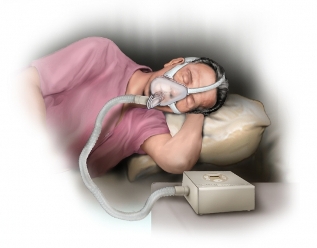Mechanism of action of continuous positive airway pressure therapy iv
Table of Contents
Table of Contents
Are you or a loved one suffering from sleep apnea? Continuous positive airway pressure therapy may be a solution. Not only can this therapy improve your breathing and sleep quality, but it can also involve caregivers in the process. In this post, we will explore the benefits of continuous positive airway pressure therapy and why caregiver involvement matters.
The Pain Points of Sleep Apnea
Sleep apnea can cause a variety of problems, including loud snoring, fatigue, and high blood pressure. Individuals with sleep apnea may also experience mood swings, difficulty concentrating, and morning headaches. These symptoms can have a negative impact on daily life, including work and relationships.
The Target of Continuous Positive Airway Pressure Therapy and Caregiver Involvement
Continuous positive airway pressure therapy, or CPAP, is a treatment for sleep apnea that uses a machine to deliver a constant flow of air through a mask worn over the nose and mouth. This air flow keeps the airway open, preventing snoring and other breathing issues. Caregiver involvement is essential in CPAP therapy, as the caregiver can assist in ensuring the patient uses the machine properly and comfortably. Caregivers can also provide emotional support and encouragement throughout the treatment process.
Summary of Benefits of Continuous Positive Airway Pressure Therapy and Caregiver Involvement
Continuous positive airway pressure therapy and caregiver involvement can improve overall sleep quality, decrease daytime fatigue, and reduce the risk of serious health issues such as high blood pressure. Caregivers can play an important role in helping patients adapt to CPAP therapy and ensure proper use of the machine. With regular use, CPAP therapy can greatly improve the quality of life for those suffering from sleep apnea.
The Importance of Caregiver Involvement in CPAP Therapy
Caregivers can help patients adjust to using the CPAP machine and mask. It is important to make sure that the mask fits comfortably and that the machine is set to the correct air pressure. Caregivers can also help motivate patients to use the machine regularly, as consistent use is essential for the therapy’s effectiveness.
My personal experience with CPAP therapy showed me the importance of caregiver involvement. My husband was diagnosed with sleep apnea and began using a CPAP machine. At first, he struggled to use the machine consistently and complained about the discomfort and noise. However, with my encouragement and support, he began using the machine more often and found a comfortable mask that fit well. Now, he sleeps soundly and feels more alert during the day.
The Benefits of Continuous Positive Airway Pressure Therapy
Not only does CPAP therapy improve sleep quality and reduce the risk of health issues, but it can also have positive effects on relationships. Snoring and other sleep apnea symptoms can cause tension between partners, but CPAP therapy can resolve these issues and improve communication. Additionally, CPAP therapy can reduce the risk of accidents caused by daytime fatigue and increase productivity at work or school.
How to Encourage Consistent Use of CPAP Therapy
Encouragement and emotional support are key to ensuring consistent use of the CPAP machine. Caregivers can help by creating a comfortable sleep environment, making sure the machine is set up properly, and assisting with any issues or concerns that arise. It is also important to celebrate small victories, such as using the machine for a full night or noticing a decrease in snoring.
Tips for Successful CPAP Therapy
Some tips for successful CPAP therapy include using a comfortable mask, staying consistent with use, and keeping the machine clean and well-maintained. It may be helpful to create a routine around using the machine, such as putting it on at the same time each night. It is important to communicate any concerns or discomfort with the healthcare provider.
Question and Answer
Q: Can CPAP therapy be used for other conditions?
A: Yes, CPAP therapy is also used to treat other breathing-related disorders such as COPD and asthma.
Q: How do I know if I am a candidate for CPAP therapy?
A: A healthcare provider can perform a sleep study to diagnose sleep apnea and determine if CPAP therapy is a viable treatment option.
Q: How long does it take to adjust to using the CPAP machine?
A: It may take several days or weeks to adjust to using the CPAP machine, but with consistent use and proper caregiver involvement, patients can adapt to the therapy.
Q: Is it possible to travel with the CPAP machine?
A: Yes, there are travel-friendly CPAP machines available, and caregivers can help pack and set up the machine for travel.
Conclusion of Continuous Positive Airway Pressure Therapy and Caregiver Involvement
Continuous positive airway pressure therapy is a vital treatment option for those suffering from sleep apnea. Caregiver involvement is essential in ensuring successful use of the CPAP machine, and can greatly improve patients’ quality of life. With consistent use and support, CPAP therapy can resolve sleep apnea symptoms and promote overall health and well-being.
Gallery
What You Should Know About Continuous Positive Airway Pressure (CPAP

Photo Credit by: bing.com / cpap airway continuous
Mechanism Of Action Of Continuous Positive Airway Pressure Therapy IV

Photo Credit by: bing.com / airway pressure positive continuous therapy iv
Continuous Positive Airway Pressure (CPAP) Devices Market

Photo Credit by: bing.com / pressure positive airway continuous cpap devices types market machine breathing bipap different insights premium press release
Continuous Positive Airway Pressure Therapy | Nursing Information

Photo Credit by: bing.com / pressure continuous positive airway therapy
Continuous Positive Airway Pressure (CPAP) -Therapie

Photo Credit by: bing.com / cpap apnea airway nasal sleepers suffering bipap snoring therapie hable dificultades prism somsak eyeem using copd galeon fitnesslifestylehealthclub




